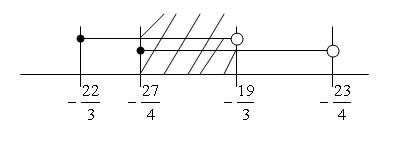- #1
Jameson
Gold Member
MHB
- 4,541
- 13
Thank you to MarkFL for this problem!
Solve the following equation:
$\displaystyle \left\lfloor x+\frac{7}{3} \right\rfloor^2+\left\lfloor x-\frac{9}{4} \right\rfloor=16$
Note: $\displaystyle \lfloor x \rfloor$ denotes the largest integer not greater than $x$. This function, referred to as the floor function, is also called the greatest integer function, and its value at $x$ is called the integral part or integer part of $x$.
--------------------
Solve the following equation:
$\displaystyle \left\lfloor x+\frac{7}{3} \right\rfloor^2+\left\lfloor x-\frac{9}{4} \right\rfloor=16$
Note: $\displaystyle \lfloor x \rfloor$ denotes the largest integer not greater than $x$. This function, referred to as the floor function, is also called the greatest integer function, and its value at $x$ is called the integral part or integer part of $x$.
--------------------

